Plein air painting with a human subject that tells a story can be a challenge, especially outdoors. Yet my friend, Scott Tallman Powers makes the process look so easy!
Scott’s process includes plein air painting, photography, compositional studies and studio work. He frequently paints on location and creates reference material to use back in his Idaho studio. He also travels the world and is inspired by many different cultures, including our own. It’s no wonder why his award winning figurative and portrait paintings are Internationally recognized.
I am thrilled to share Scott’s winning figurative and portrait painting techniques here…
Plein Air Painting the Live Model Outdoors
Work out your composition well before you start painting. This will make the beginning process much smoother. When I am laying out my painting on my canvas I like to keep a thought in mind, “general to the specific.” Work from the largest, most ‘general’ shapes to the smallest, most ‘specific’ shapes.
I like to draw with straight lines to lay in the drawing. Trying not to get too detailed too soon. Constructing the armature that will support your painting is a fun and exhilarating part of the process. Don’t take it lightly though. Putting the thoughtful, accurate effort into your piece in the beginning will save you loads of time in corrections. I learned this the hard way.
Think about the story that you are try to tell the entire way through the painting. Put yourself there. Painting the figure from life and from photos takes a lot of measuring, planning, and a lot of easel time, but it is well worth it. Your hard efforts will come through in your finish piece.
Outdoors the weather and light is constantly changing. Depicting your subject in the morning light as opposed to afternoon light can drastically change the mood and feel to your piece. Plan the time of day and stick to it.
Step 1. Working Out the Concept

This is one of the most important steps. You need to have a good concept first before you begin to paint.
Use your sketchbook, and get the idea on paper. Don’t be concerned with accuracy in drawing at this stage. Most of my idea sketches are just scribbles. Once you have the idea and composition flushed out, then do a more refined sketch.
Step 2. The Photo Shoot
Photo shoots can be a lot of fun. Try out different plein air painting scenes on location as well as different costumes, tools and other props that support the story. Animals may play a part also. Working with animals is a whole other discussion!
Take shots from different directions and vantage points. Go to your scene at different times of day to see what the light looks like. Light at different times of day can make the viewer feel different things. You want to choose the time of day that best suits the concept for your painting.
Step 3. The Sketch
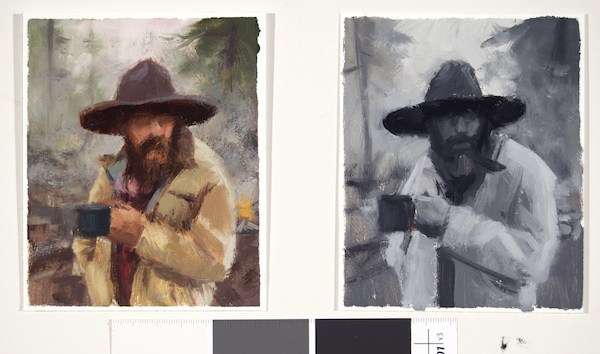
Now, you will be building off your initial small rough concept idea sketch and your photos. For this I gessoed some matte board for the sketches.
Think in values of black and white and layout your largest shapes, making sure there is a separation between the foreground and background. Design your masses to balance and support your idea.
With #6, #4, #2 Filbert bristle brushes, work out your composition the best you can. This is the planning process you will need when you start your painting from the live model. This planning will save you time which will also save you money in model fees.
Using the black and white value sketch and photos, start the rough color sketch for the painting. Think about your color harmonies. Based off of your sketches and photos, begin to feel out your scene in color. It will reveal itself as you go along. Will it be more of a red/green harmony, a violet/yellow, Blue/ orange, or Yellow/green-violet/red, etc.?
Step 4. The Drawing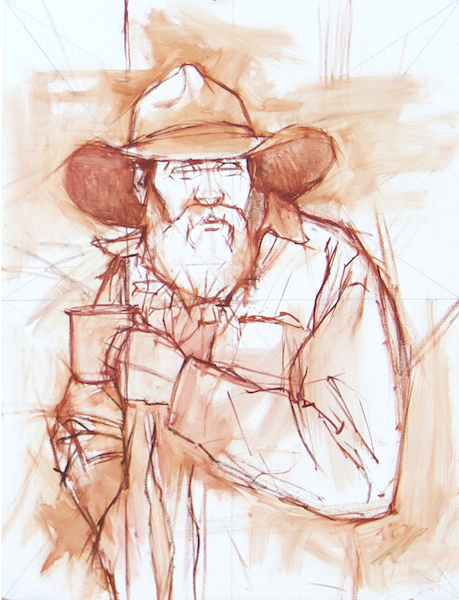
For the rough sketch use Venetian red and Burnt Umber to help place the model on the canvas. Start drawing with straight lines on a white or lightly toned canvas.
Once the composition is roughly placed on the canvas then find the correct head size of your model to accurately place the model within the canvas boarders. Measure the head of your model with the brush handle. Start measuring down the figure and across.
Next, draw a light plumb line on one side of the head of the model to help you measure horizontally using your head measurement. Place your points lightly on the canvas and use them to find the locations of the arm, hands, cup, etc. Take your time with this.
Use the head unit to measure vertically and horizontally to place the rest of the figure on the canvas. When you get to smaller measurements, divide the head unit in half and find where that lands on your model and use that for smaller measurements.
This drawing stage will take some time, but it will be worth the effort in the long run.
Step 5. The Block-in
Blocking-in helps establish the mood and key or color of the painting. This painting is to be a softly lit early morning, smoky scene, so first establish darkest dark and lightest light.
Use the #10, #8, #6, #4 filbert bristle brushes for Step 5. Work very thinly and use only gamsol to thin the paints. There will be many layers on this painting, so always try to think a few steps ahead.
After the extremes are established, then move to the largest shapes. Lay them in thinly but directly. Continue to adjust these masses until the key and the mood are set
Color Mixtures: Primary base mixture for flesh- Venetian red, Yellow Ochre, Titanium White with variations of warm and cool based off the temperature of the light which was cool. Cool light/Warm shadows. Add variations of grey green and blue into the flesh tones to cool it off where needed. Also add a bit of Cadmium Red Deep and Cadmium Scarlet in the warmest places in the flesh.
My approach to mixing and color choices changes with every subject and scene. I don’t really have a formula for skin tones because I have found it changes greatly with the surrounding environment. (Check out this post about mixing skin tones.)
Securing your darkest dark and lightest light along with your strongest color (most saturated), you can relate your decisions to these extremes to build your foundation for your future decisions.
Step 6. Re-drawing
Re-draw the figure and background elements using a slightly darker or lighter color of the area you are working.
Go over your measurements again and again until the figure is in proper proportion and the action in the figure feels right. Re-drawing is an important step to re-solidify and correct anything that may not look right once the block-in had been established.
For Step 6 use, #10, #8, #6, #4 filbert bristle brushes Various sizes of round-red sables, Long flat badger hair brushes, Badger hair fan brushes
For this scene there is a predominant greenish/violet cast to most thing. So, mix up a large mother pile of that greenish/ violet and introduce it into the mixtures in the clothing, hat and parts of the reflected light within the flesh. Use White, Sap green, Alizarin Crimson Perm., with a touch of prussian blue/black.
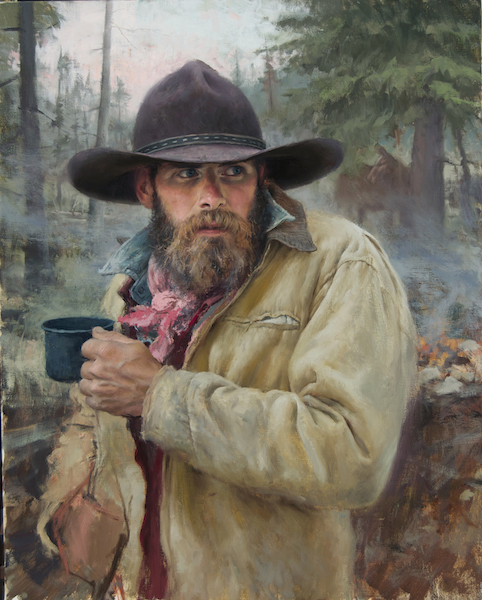
Step 7. Building the Form
It’s time to progress to the second and third layers of painting. In this stage use the medium and begin to model the form of the figure. For this stage again use the #10, #8, #6 #4 Filbert bristle brushes and various sizes of round-red sables, Flat badger, and a badger hair Fan brush,
Work back and forth from the background to the foreground. Make sure the skin tones and the clothing are working properly with the light and the temperature of the environment.
Do a bit of glazing in the shadows of the jacket to warm it up. For this use a bit of Gold ochre and transparent oxide brown, then rub it off the dry surface.
Step 8. Finishing Up
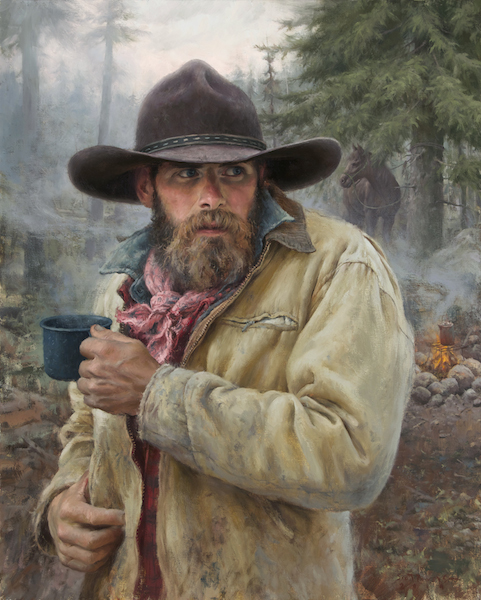
This is where things really slow down. Take your time with the finish. Go back over the main idea of your painting and make sure you focus on the most important locations of your painting that helps to tell the story. Use the #10, #8, #6, and #4 Filbert bristle brushes.
Sharpen certain edges with the palette knife, and soften others with the softer brushes and Fan brush to enhance the form of the figure and push other masses farther back in the distance. Make slight adjustments to drawing, temperatures and values to strengthen the painting if needed.
Look at the painting as a whole and make sure everything is communicating with each other.
Scott’s Materials List: Canvas: Medium Textured Claussens Belgian Linen- Double Oil primed. (30”x24”), Oils: Williamsburg Titanium White (soft white), Holbein Titanium White(stiff white), Cadmium Yellow, Cadmium Scarlet, Cadmium Red Deep, Alizarin Crimson, PermanentYellow,Yellow Ochre, Venetian Red, Transparent Oxide Red, Burnt Umber, Raw Umber, Shale (Vasari), Sap Green, Prussian Blue, and Ivory Black mixed together- (30% Prussian Blue-70%Ivory Black),Cool Grey Sage (Vasari) Brushes:Filbert bristle brushes-#2-10, Sable Brushes- #0-10, Badger hair brushes- long flats-#4-6, Long handled filbert bristle brushes #2-8, A few handmade bristle brushes. Painting scrapers: pear-shaped scraper, curved blade exacto knife, 220 grit emory paper, Solvent: Gamsol Paint Thinner, Medium: Oleorezgel (Natural Pigments), Meyers Medium: 1part Stand oil, 1part Damar varnish, 5 parts mineral spirits, Impasto Medium: (Natural Pigments) Sculptor’s calipers: used to measure relentlessly. Things have a way of sliding out of accuracy, so you need to stay on top of your measurements. Remeasuring is a must. Find a unit of measurement like the head height in relation to the arm length, etc. Dividers: dividers used to do the same thing but just in smaller units, for example, the width of the hands in relation to the halfway point of the head height, Extra: 8×10 mirror. “Always have a mirror handy every time you are painting or drawing. Looking at your work and your subject in reverse reveals many things. The mirror helps to correct drawing and design.
Guest artist/author: Scott Tallman Powers is an award winning oil paintings are in many galleries, private collections, and museums in the US and around the world. He is a signature member of the Oil Painters of America and is the founder of “The Plein Air Painters of Chicago” group.


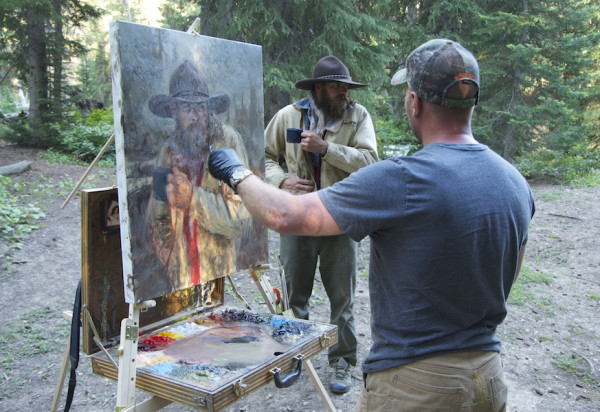
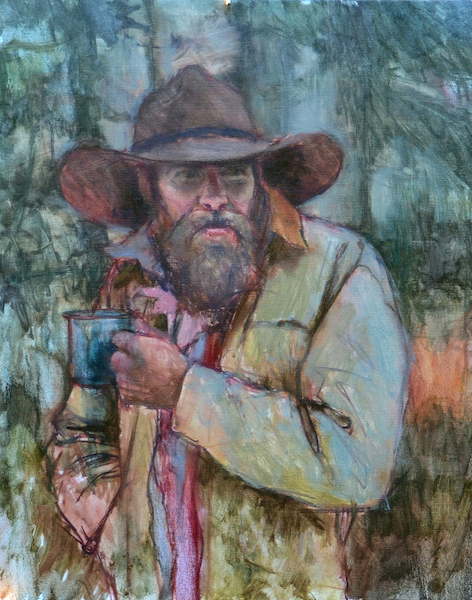
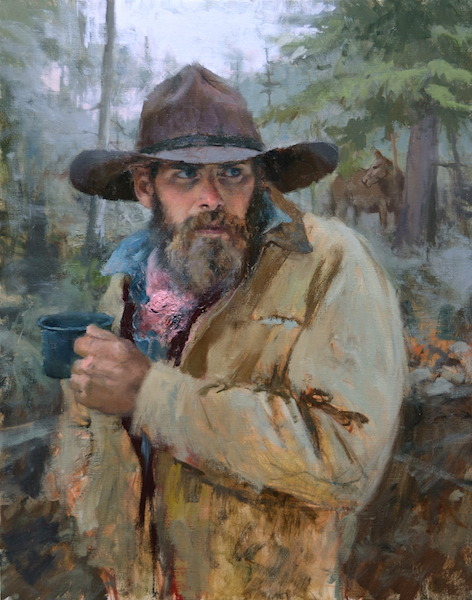





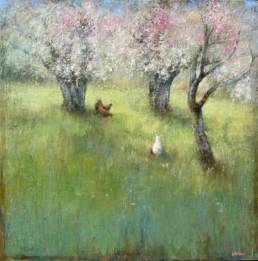
I’ve had the pleasure of watching Scott paint in real life. His work is masterful, and to top it off,mes a nice guy too!
Oh.. I want to say that this is a helpful and thorough post. Thanks Lori and Scott!
Hi, can you tell me the brand name and type of easel the artist is using?
Thanks,
Kristine
I do not know – now, I want to know too! Send Scott and email and tell him Lori sent you stpfineart@gmail.com